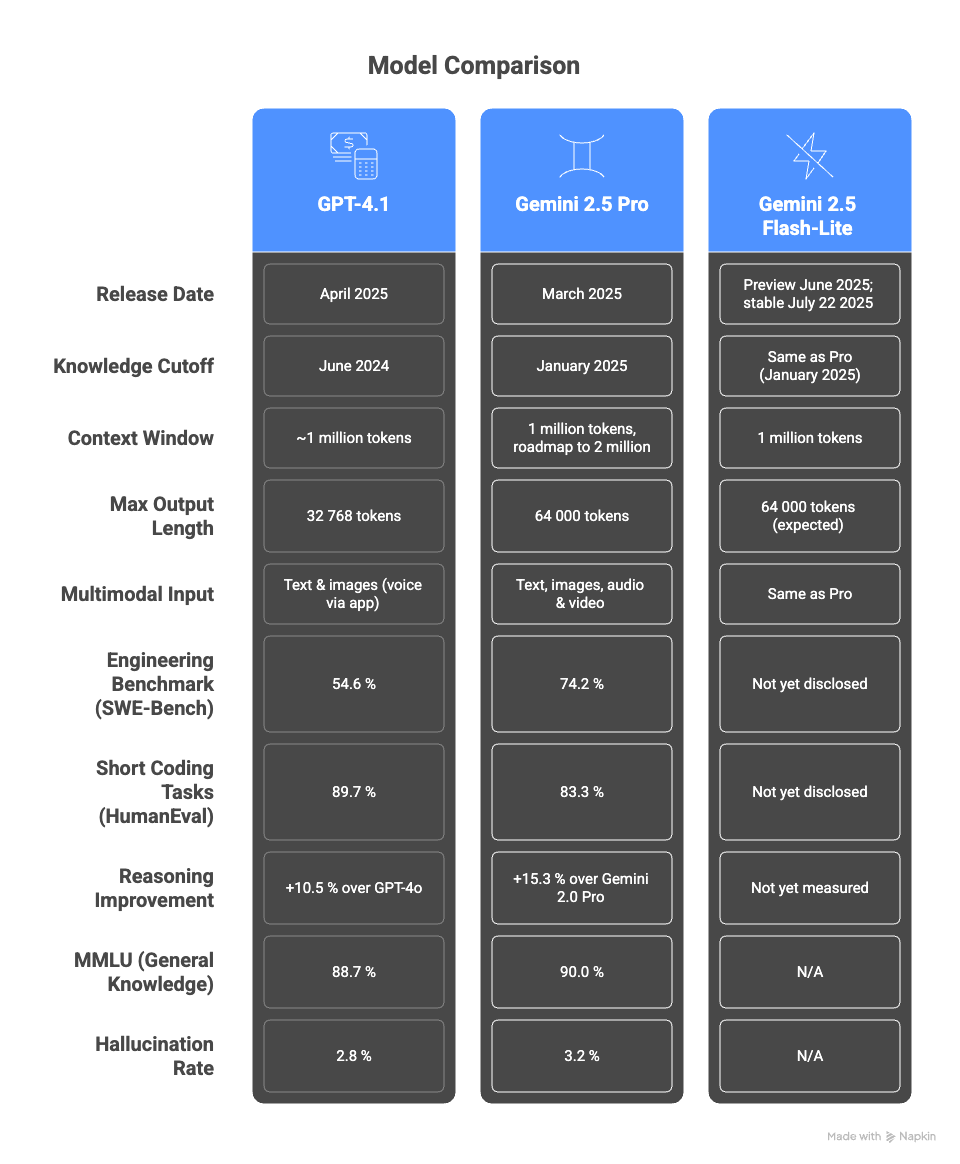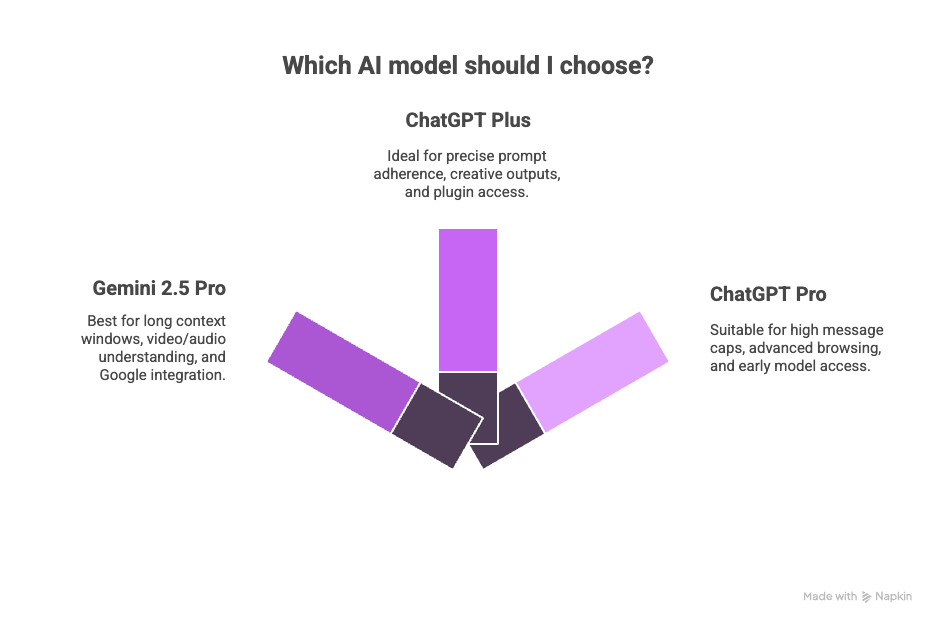Imagine choosing between two super‑powered coding partners – one that thinks with a deep understanding of vast datasets, and one that offers unparalleled conversational fluidity and integration.
Which would you trust to meet your deadlines in July 2025? Let’s dive into Google’s Gemini Advanced and OpenAI’s latest models and see which AI sidekick is best for you.
Large language models are evolving at lightspeed. Many of us grew comfortable asking ChatGPT everything from debugging advice to content outlines. Then Google rebranded its Bard chatbot as Gemini and offered a paid Gemini Advanced subscription.
In this article…
Let’s now explore them in a friendly comparison.
Model Line‑up & Availability
Gemini family (Google)
- Gemini 2.5 Pro — released in March 2025 and generally available since July 2025. According to the Google Developer Blog, it offers a million‑token context window and can understand text, images, audio and video.
- Gemini 2.5 Flash — a cost‑efficient model optimized for high‑volume tasks; also generally available as of July 2025.
- Gemini 2.5 Flash‑Lite — initially launched in preview, it became stable on 22 July 2025. Google calls it its fastest and lowest‑cost model. A post on the Google Developer Blog notes that Flash‑Lite has lower latency than previous Flash models, costs $0.10 per million input tokens and $0.40 per million output tokens, and maintains a 1‑million‑token context window with controllable thinking budgets. It also improves coding, math and reasoning tasks and supports native tools like search grounding and code execution.
GPT‑4 series (OpenAI)
- GPT‑4o — introduced in May 2024 as the general‑purpose multimodal model. It supports text and images (with voice via the ChatGPT app) and powers the consumer ChatGPT Plus subscription.
- GPT‑4.1 — rolled out in April 2025 and tailored for long‑context tasks. It offers roughly a 1‑million‑token context window, an output limit around 32 768 tokens and improved reasoning. Variants like GPT‑4o1 and GPT‑4o‑mini underpin the premium ChatGPT Pro plan.
- GPT‑5 (rumoured) — Reuters reports that OpenAI plans to launch GPT‑5 in August 2025, but it is not yet publicly available, so this guide focuses on GPT‑4‑series models.

Also Read: GitHub Copilot Review: Is It Worth Your Developer Vibes?
Pricing & Plans
| Plan | Price (USD/month) | What’s included | Notes |
| Gemini Advanced (Pro) | ≈$19.99 | Access to Gemini 2.5 Pro & Flash; 2 TB Google One storage; NotebookLM (research aid); Veo 3 video model (preview); integration across Gmail, Docs and Sheets. | Not available everywhere; document uploads work best when files reside in Google Workspace. |
| ChatGPT Plus | $20 | Access to GPT‑4o (general use); occasional access to GPT‑4.1; DALL‑E 3 image generation; custom GPTs; plugin store; voice & image input. | Message limits apply — roughly 150 messages every 3 hours for GPT‑4o and fewer for GPT‑4.1. |
| ChatGPT Pro | $200 | Access to GPT‑4o, GPT‑4.1 and o1/o1‑mini models; priority compute; increased message caps; deep‑research agent (≈250 runs per month); advanced browsing and file analysis; early video generation. | Designed for researchers and engineers needing high throughput. |
| Gemini 2.5 Flash‑Lite | Pay‑as‑you‑go: $0.10 / 1 M input tokens & $0.40 / 1 M output tokens | Stable since 22 July 2025. Lower latency and better price‑performance than previous Flash models. Includes a 1‑million‑token context window and support for native tools. | Ideal for high‑volume translation or classification workloads. |
Also Read: 5 Top AI-Powered VS Code Extensions That Every Developer Needs
Technical Metrics
| Metric | GPT‑4.1 | Gemini 2.5 Pro | Gemini 2.5 Flash‑Lite | Discussion |
| Release date | April 2025 | March 2025 | Preview June 2025; stable July 22 2025 | GPT‑4o preceded 4.1 (May 2024) but 4.1 targets long‑context tasks. |
| Knowledge cutoff | June 2024 | January 2025 | Same as Pro (January 2025) | Gemini models use slightly more recent training data. |
| Context window | ~1 million tokens (4.1); GPT‑4o widely reported at 128k | 1 million tokens, with roadmap to 2 million | 1 million tokens | Allows processing of large codebases or documents. |
| Max output length | 32 768 tokens | 64 000 tokens | 64 000 tokens (expected) | Longer outputs enable comprehensive responses. |
| Multimodal input | Text & images (voice via app) | Text, images, audio & video | Same as Pro | Gemini handles audio/video natively; GPT‑4o handles voice, not video. |
| Engineering benchmark (SWE‑Bench) | 54.6 % | 74.2 % | Not yet disclosed | Higher scores mean better at real bug‑fixing; 2.5 Pro excels here. |
| Short coding tasks (HumanEval) | 89.7 % | 83.3 % | Not yet disclosed | GPT‑4.1 excels at algorithmic snippets. |
| Reasoning improvement | +10.5 % over GPT‑4o | +15.3 % over Gemini 2.0 Pro | Not yet measured | Measures multi‑step reasoning gains. |
| MMLU (general knowledge) | 88.7 % | 90.0 % | N/A | Gemini slightly outperforms GPT‑4.1. |
| Hallucination rate | 2.8 % | 3.2 % | N/A | Lower values indicate more factual reliability; human verification still needed. |
Developer Experience & Ecosystem
Prompt handling & coherence
Hands‑on reviews note that GPT‑4 models tend to follow complex, constraint‑heavy prompts more precisely than Gemini.
For example, ChatGPT produced a structured poem under 100 words when requested, while Gemini sometimes exceeded the limit or wandered off topic.
Gemini does provide multiple draft responses and can cross‑reference Google Search for verification.
Coding support
Benchmark data suggest Gemini 2.5 Pro outperforms GPT‑4.1 on SWE‑Bench (real‑world bug‑fixing), whereas GPT‑4.1 dominates in HumanEval (short coding tasks).
In day‑to‑day usage, developers often favour ChatGPT’s code interpreter and plugin ecosystem for quick iteration and debugging.
Gemini integrates with Google Cloud, AI Studio, and Vertex AI, offering deep integration with the broader Google ecosystem.
Integration & tools
ChatGPT offers a broad plugin marketplace that connects to services like Notion, Slack, and Microsoft Office. The Pro tier adds a deep‑research agent, advanced browsing, and file analysis tools.
Gemini is deeply woven into Google Workspace. It can compose emails, generate documents and spreadsheets, and even serve as your phone’s assistant.
NotebookLM helps structure research, and the Veo 3 video model (in preview) allows synthetic video creation.
Privacy & safety
Google allows users to opt out of having their conversations used for training and enforces strict content‑safety measures, but usage data may still be collected.
OpenAI offers enterprise tiers with stronger privacy guarantees and configurable data retention.
Bias tests suggest Gemini tends to give more neutral responses, yet sometimes lacks context, while ChatGPT can show uneven sensitivity.
When to Choose Each Gemini or ChatGPT Model for Coding?

- Choose Gemini 2.5 Pro if you need extremely long context windows, native video/audio understanding, slightly more recent knowledge, or seamless integration with Google Workspace and Android.
Its superior SWE‑Bench score makes it attractive for troubleshooting large codebases. The Flash and Flash‑Lite variants provide lower‑cost options for translation, classification or latency‑sensitive workloads; Flash‑Lite’s pay‑as‑you‑go pricing is compelling for high‑volume tasks.
- Choose ChatGPT Plus if you prioritise precise prompt adherence, a user‑friendly interface, creative outputs via DALL‑E, and access to a rich plugin ecosystem.
GPT‑4.1’s HumanEval strength makes it an excellent assistant for algorithmic tasks and day‑to‑day coding. ChatGPT is widely available globally and offers voice interfaces on mobile.
- Upgrade to ChatGPT Pro if you are a power user or researcher who needs high message caps, advanced browsing, and file analysis, or early access to experimental models. Your workload should justify the $200 price.
Conclusion
Both Google and OpenAI continue to push the boundaries of AI. Gemini emphasizes breadth — huge context windows, multimodal inputs, and deep ecosystem integration. GPT‑4 emphasizes depth, precise instruction following, creative generation, and a rich plugin marketplace.
The July 2025 stabilisation of Gemini 2.5 Flash‑Lite shows Google’s focus on cost‑efficient models, while OpenAI’s plans for GPT‑5 point to further advances. When selecting an AI partner, developers should assess their tasks (e.g., long documents vs. short code snippets), ecosystem preferences, privacy requirements, and budget.

Interesting breakdown! I’m curious—do you think Gemini’s higher SWE-Bench score will actually outweigh GPT-4.1’s stronger HumanEval results in day-to-day coding, or will it depend entirely on project type?
It’ll likely depend on the project type—SWE-Bench leans toward real-world bug fixing, while HumanEval measures algorithmic problem-solving, so each model’s advantage will shine in different coding scenarios.
Awesome comparison! For those using both Gemini and GPT-4, what’s been your experience with coding support?
Great question! I’ve tried both, and found that GPT-4 often gives more detailed explanations and context with its code suggestions, while Gemini is super quick and handles straightforward tasks well. Both have their strengths, so I usually switch between them depending on the complexity of my project.